Economics Assignment: PPEV5040 Public Policy Analysis Report
VerifiedAdded on 2023/06/10
|21
|4894
|179
Report
AI Summary
This economics assignment delves into the intricacies of public policy analysis, presenting a comprehensive examination of key issues in problem construction and deconstruction, theory of change, stakeholder analysis, and stakeholder mapping. The assignment then applies these concepts to a specific public policy problem in Nigeria, exploring its construction and deconstruction, developing a theory of change, conducting a stakeholder analysis, and creating a stakeholder map. Furthermore, the assignment analyzes a project focused on the prevention of maternal deaths, evaluating its progress and financial aspects. The solution provides detailed insights into the complexities of policy implementation and evaluation within a developing country context. The document covers topics such as public policy problem in Nigeria, stakeholders involved, theory of change and stakeholder mapping.
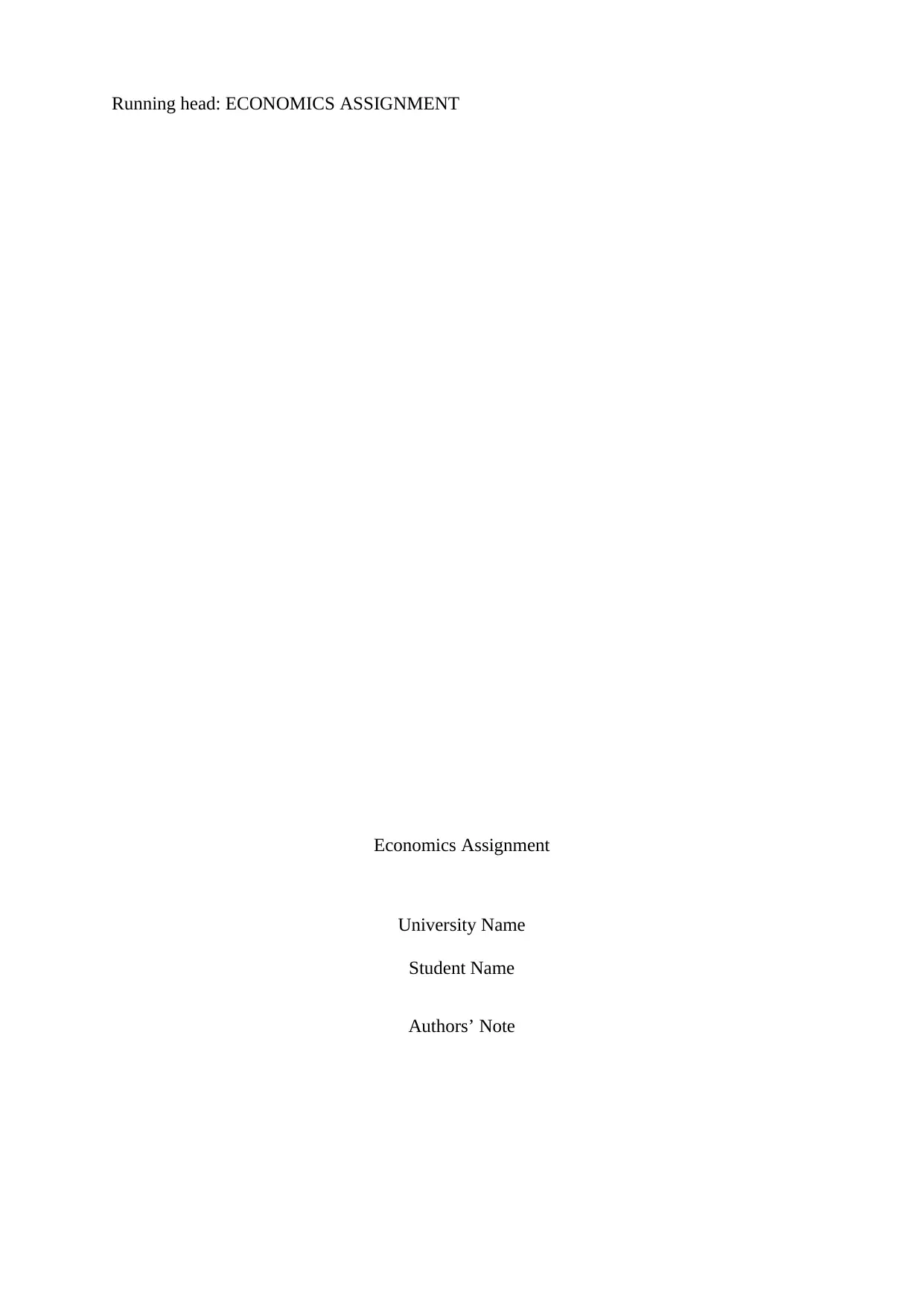
Running head: ECONOMICS ASSIGNMENT
Economics Assignment
University Name
Student Name
Authors’ Note
Economics Assignment
University Name
Student Name
Authors’ Note
Paraphrase This Document
Need a fresh take? Get an instant paraphrase of this document with our AI Paraphraser
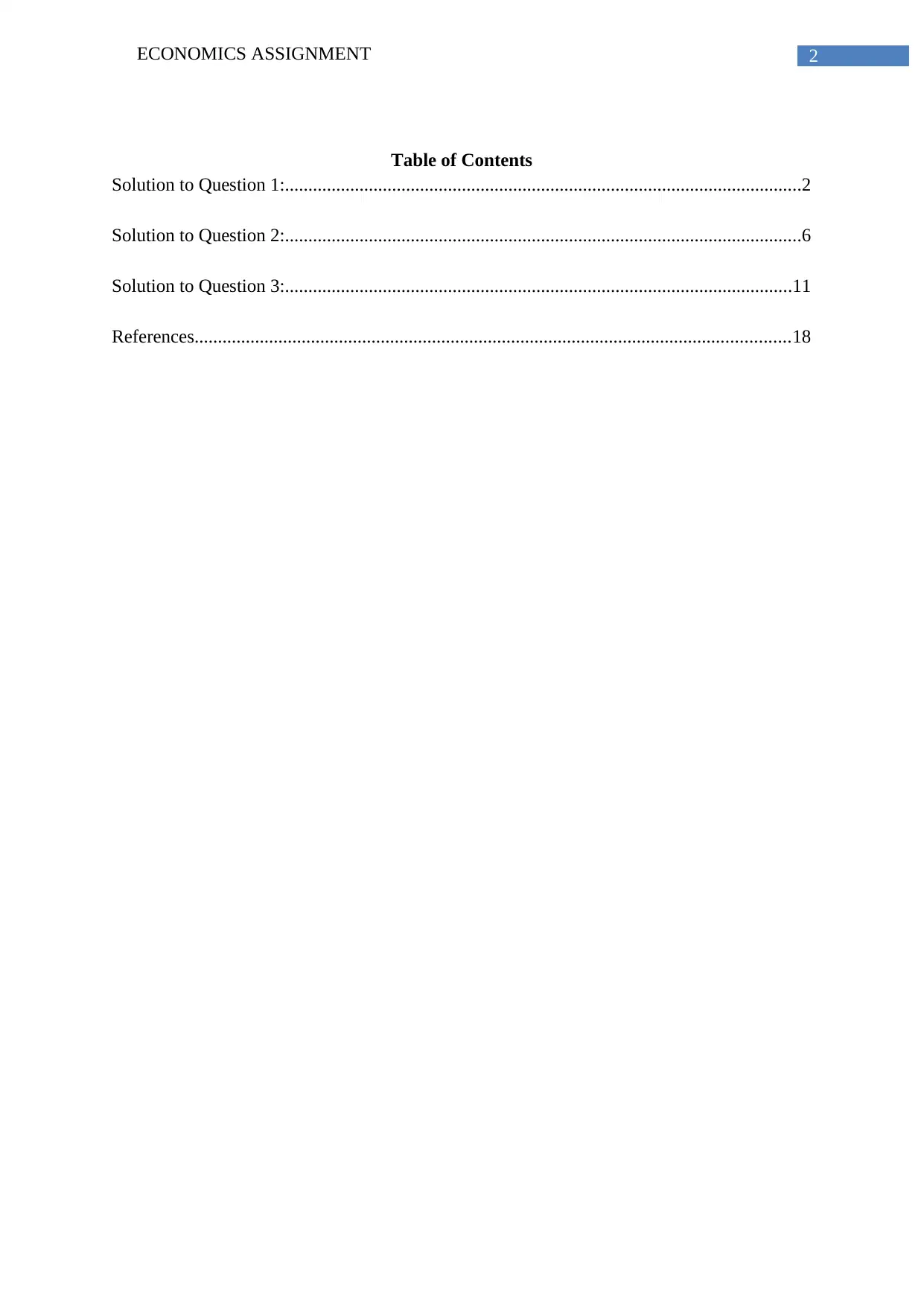
2ECONOMICS ASSIGNMENT
Table of Contents
Solution to Question 1:...............................................................................................................2
Solution to Question 2:...............................................................................................................6
Solution to Question 3:.............................................................................................................11
References................................................................................................................................18
Table of Contents
Solution to Question 1:...............................................................................................................2
Solution to Question 2:...............................................................................................................6
Solution to Question 3:.............................................................................................................11
References................................................................................................................................18
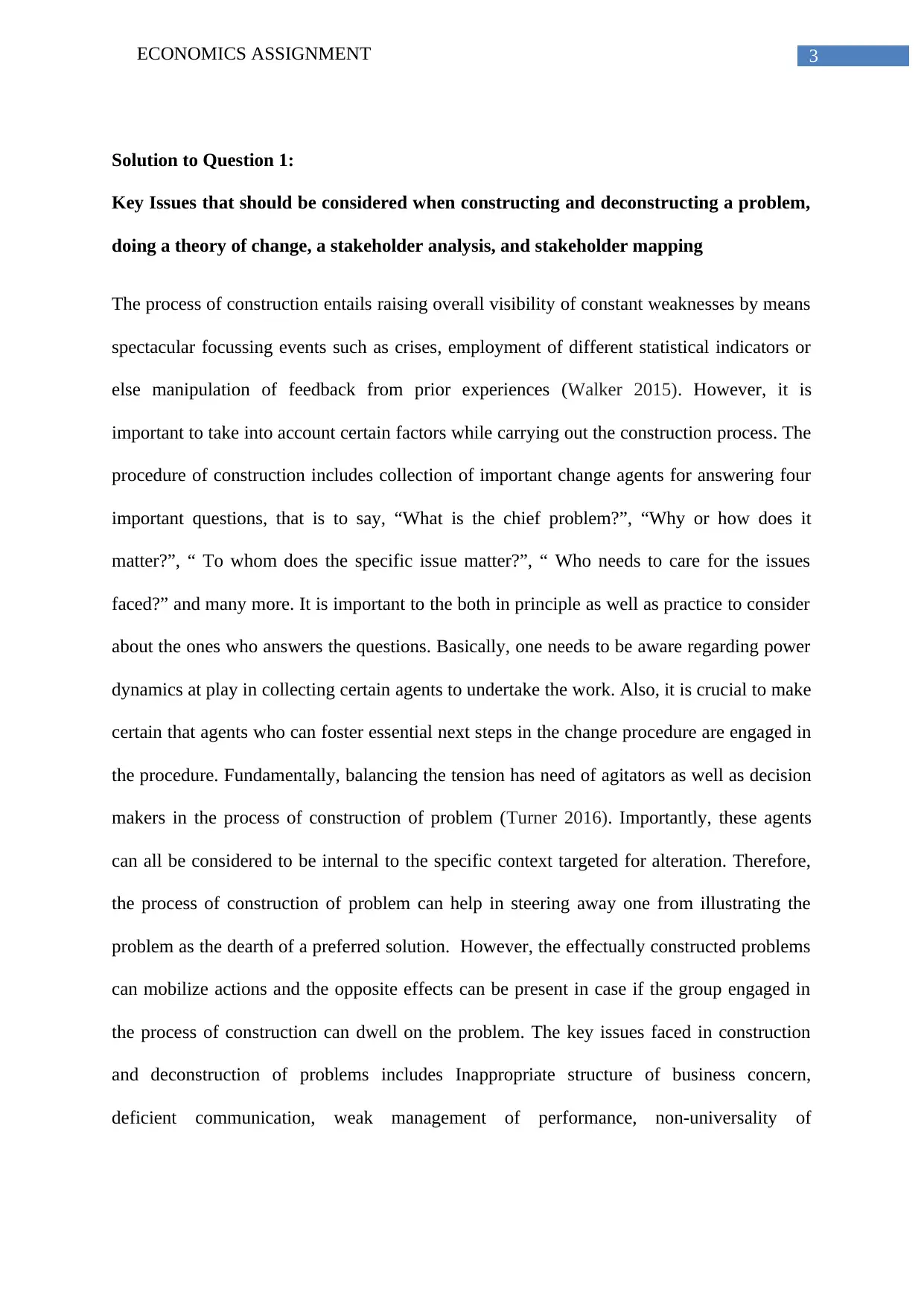
3ECONOMICS ASSIGNMENT
Solution to Question 1:
Key Issues that should be considered when constructing and deconstructing a problem,
doing a theory of change, a stakeholder analysis, and stakeholder mapping
The process of construction entails raising overall visibility of constant weaknesses by means
spectacular focussing events such as crises, employment of different statistical indicators or
else manipulation of feedback from prior experiences (Walker 2015). However, it is
important to take into account certain factors while carrying out the construction process. The
procedure of construction includes collection of important change agents for answering four
important questions, that is to say, “What is the chief problem?”, “Why or how does it
matter?”, “ To whom does the specific issue matter?”, “ Who needs to care for the issues
faced?” and many more. It is important to the both in principle as well as practice to consider
about the ones who answers the questions. Basically, one needs to be aware regarding power
dynamics at play in collecting certain agents to undertake the work. Also, it is crucial to make
certain that agents who can foster essential next steps in the change procedure are engaged in
the procedure. Fundamentally, balancing the tension has need of agitators as well as decision
makers in the process of construction of problem (Turner 2016). Importantly, these agents
can all be considered to be internal to the specific context targeted for alteration. Therefore,
the process of construction of problem can help in steering away one from illustrating the
problem as the dearth of a preferred solution. However, the effectually constructed problems
can mobilize actions and the opposite effects can be present in case if the group engaged in
the process of construction can dwell on the problem. The key issues faced in construction
and deconstruction of problems includes Inappropriate structure of business concern,
deficient communication, weak management of performance, non-universality of
Solution to Question 1:
Key Issues that should be considered when constructing and deconstructing a problem,
doing a theory of change, a stakeholder analysis, and stakeholder mapping
The process of construction entails raising overall visibility of constant weaknesses by means
spectacular focussing events such as crises, employment of different statistical indicators or
else manipulation of feedback from prior experiences (Walker 2015). However, it is
important to take into account certain factors while carrying out the construction process. The
procedure of construction includes collection of important change agents for answering four
important questions, that is to say, “What is the chief problem?”, “Why or how does it
matter?”, “ To whom does the specific issue matter?”, “ Who needs to care for the issues
faced?” and many more. It is important to the both in principle as well as practice to consider
about the ones who answers the questions. Basically, one needs to be aware regarding power
dynamics at play in collecting certain agents to undertake the work. Also, it is crucial to make
certain that agents who can foster essential next steps in the change procedure are engaged in
the procedure. Fundamentally, balancing the tension has need of agitators as well as decision
makers in the process of construction of problem (Turner 2016). Importantly, these agents
can all be considered to be internal to the specific context targeted for alteration. Therefore,
the process of construction of problem can help in steering away one from illustrating the
problem as the dearth of a preferred solution. However, the effectually constructed problems
can mobilize actions and the opposite effects can be present in case if the group engaged in
the process of construction can dwell on the problem. The key issues faced in construction
and deconstruction of problems includes Inappropriate structure of business concern,
deficient communication, weak management of performance, non-universality of
⊘ This is a preview!⊘
Do you want full access?
Subscribe today to unlock all pages.

Trusted by 1+ million students worldwide
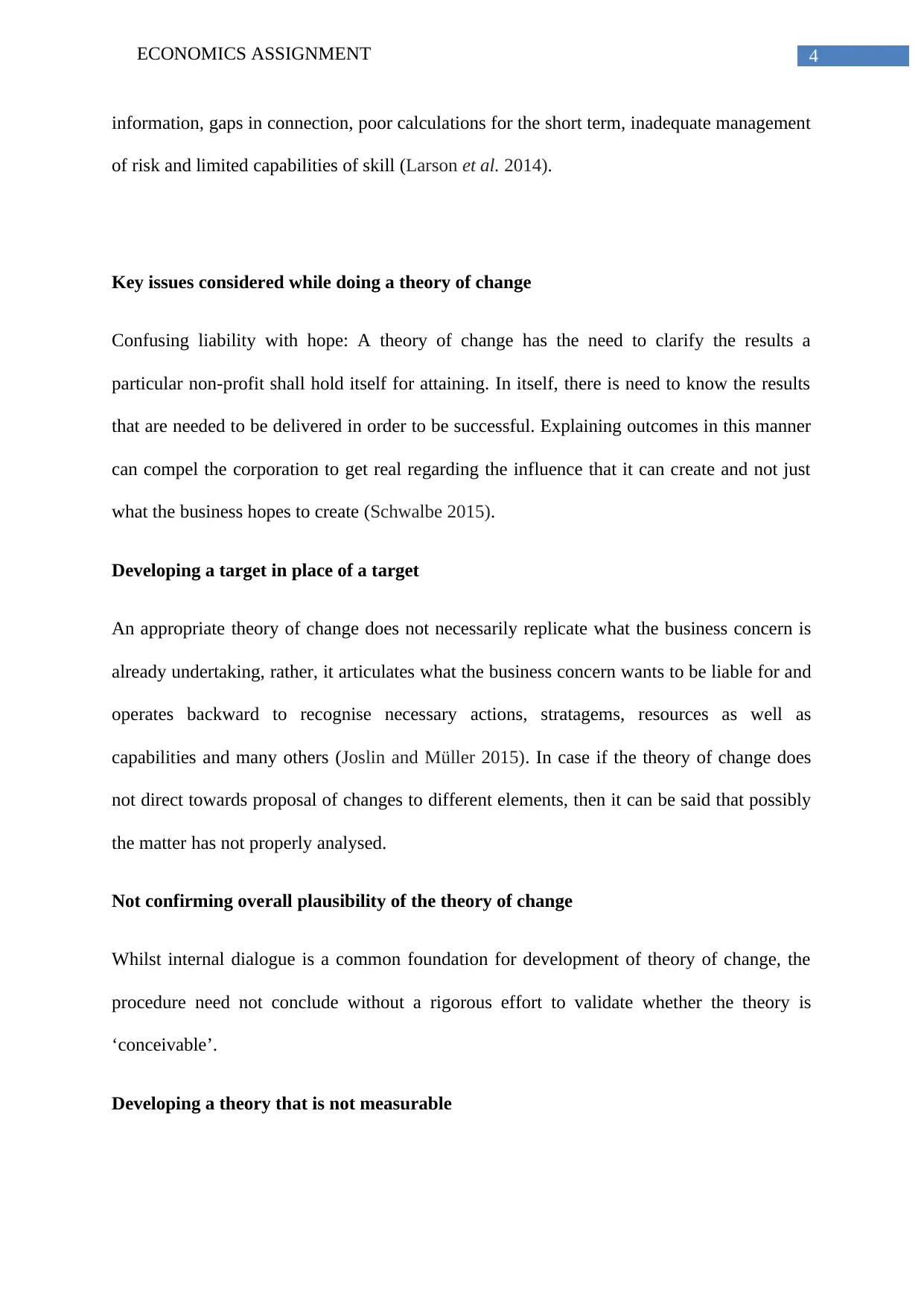
4ECONOMICS ASSIGNMENT
information, gaps in connection, poor calculations for the short term, inadequate management
of risk and limited capabilities of skill (Larson et al. 2014).
Key issues considered while doing a theory of change
Confusing liability with hope: A theory of change has the need to clarify the results a
particular non-profit shall hold itself for attaining. In itself, there is need to know the results
that are needed to be delivered in order to be successful. Explaining outcomes in this manner
can compel the corporation to get real regarding the influence that it can create and not just
what the business hopes to create (Schwalbe 2015).
Developing a target in place of a target
An appropriate theory of change does not necessarily replicate what the business concern is
already undertaking, rather, it articulates what the business concern wants to be liable for and
operates backward to recognise necessary actions, stratagems, resources as well as
capabilities and many others (Joslin and Müller 2015). In case if the theory of change does
not direct towards proposal of changes to different elements, then it can be said that possibly
the matter has not properly analysed.
Not confirming overall plausibility of the theory of change
Whilst internal dialogue is a common foundation for development of theory of change, the
procedure need not conclude without a rigorous effort to validate whether the theory is
‘conceivable’.
Developing a theory that is not measurable
information, gaps in connection, poor calculations for the short term, inadequate management
of risk and limited capabilities of skill (Larson et al. 2014).
Key issues considered while doing a theory of change
Confusing liability with hope: A theory of change has the need to clarify the results a
particular non-profit shall hold itself for attaining. In itself, there is need to know the results
that are needed to be delivered in order to be successful. Explaining outcomes in this manner
can compel the corporation to get real regarding the influence that it can create and not just
what the business hopes to create (Schwalbe 2015).
Developing a target in place of a target
An appropriate theory of change does not necessarily replicate what the business concern is
already undertaking, rather, it articulates what the business concern wants to be liable for and
operates backward to recognise necessary actions, stratagems, resources as well as
capabilities and many others (Joslin and Müller 2015). In case if the theory of change does
not direct towards proposal of changes to different elements, then it can be said that possibly
the matter has not properly analysed.
Not confirming overall plausibility of the theory of change
Whilst internal dialogue is a common foundation for development of theory of change, the
procedure need not conclude without a rigorous effort to validate whether the theory is
‘conceivable’.
Developing a theory that is not measurable
Paraphrase This Document
Need a fresh take? Get an instant paraphrase of this document with our AI Paraphraser
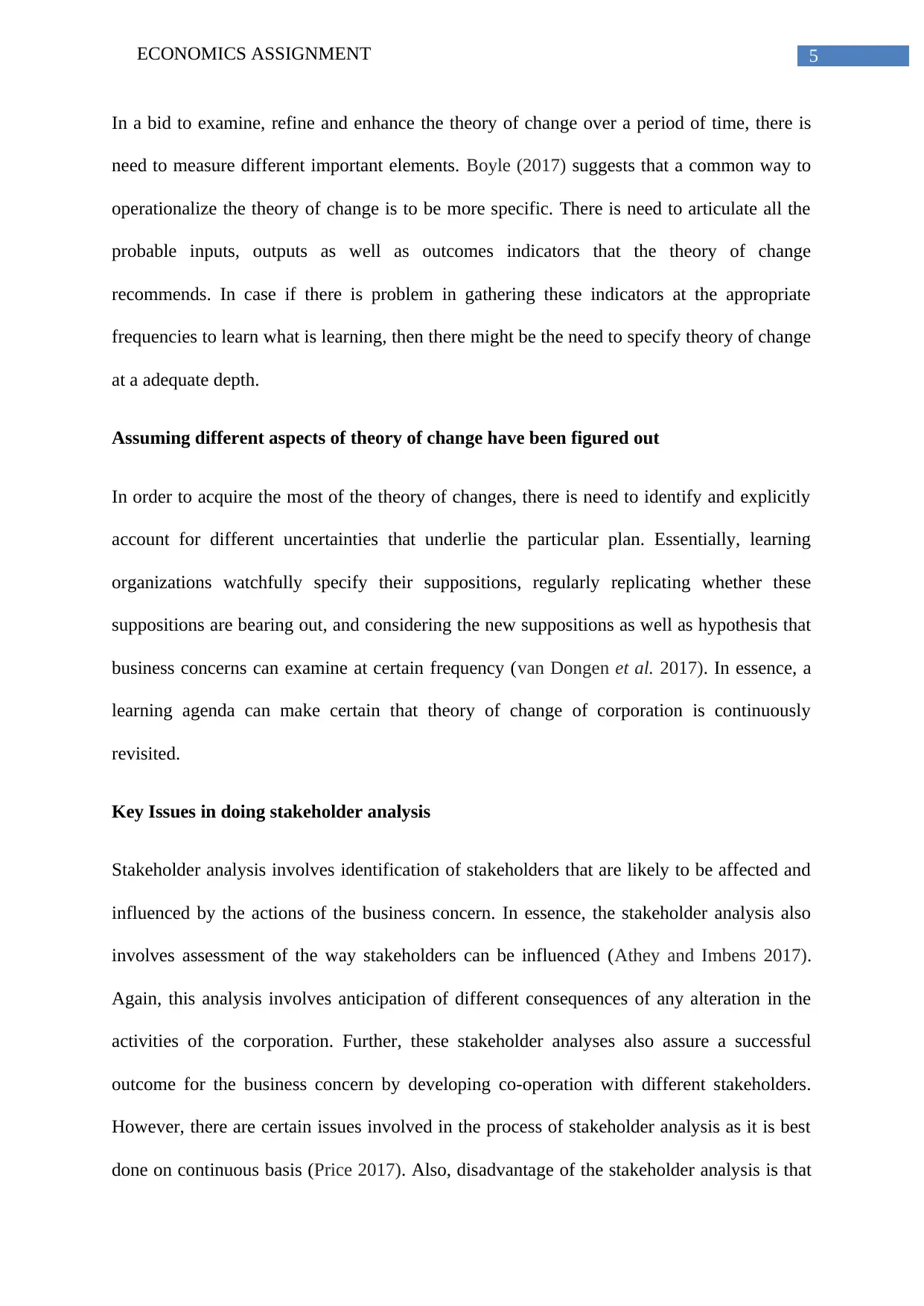
5ECONOMICS ASSIGNMENT
In a bid to examine, refine and enhance the theory of change over a period of time, there is
need to measure different important elements. Boyle (2017) suggests that a common way to
operationalize the theory of change is to be more specific. There is need to articulate all the
probable inputs, outputs as well as outcomes indicators that the theory of change
recommends. In case if there is problem in gathering these indicators at the appropriate
frequencies to learn what is learning, then there might be the need to specify theory of change
at a adequate depth.
Assuming different aspects of theory of change have been figured out
In order to acquire the most of the theory of changes, there is need to identify and explicitly
account for different uncertainties that underlie the particular plan. Essentially, learning
organizations watchfully specify their suppositions, regularly replicating whether these
suppositions are bearing out, and considering the new suppositions as well as hypothesis that
business concerns can examine at certain frequency (van Dongen et al. 2017). In essence, a
learning agenda can make certain that theory of change of corporation is continuously
revisited.
Key Issues in doing stakeholder analysis
Stakeholder analysis involves identification of stakeholders that are likely to be affected and
influenced by the actions of the business concern. In essence, the stakeholder analysis also
involves assessment of the way stakeholders can be influenced (Athey and Imbens 2017).
Again, this analysis involves anticipation of different consequences of any alteration in the
activities of the corporation. Further, these stakeholder analyses also assure a successful
outcome for the business concern by developing co-operation with different stakeholders.
However, there are certain issues involved in the process of stakeholder analysis as it is best
done on continuous basis (Price 2017). Also, disadvantage of the stakeholder analysis is that
In a bid to examine, refine and enhance the theory of change over a period of time, there is
need to measure different important elements. Boyle (2017) suggests that a common way to
operationalize the theory of change is to be more specific. There is need to articulate all the
probable inputs, outputs as well as outcomes indicators that the theory of change
recommends. In case if there is problem in gathering these indicators at the appropriate
frequencies to learn what is learning, then there might be the need to specify theory of change
at a adequate depth.
Assuming different aspects of theory of change have been figured out
In order to acquire the most of the theory of changes, there is need to identify and explicitly
account for different uncertainties that underlie the particular plan. Essentially, learning
organizations watchfully specify their suppositions, regularly replicating whether these
suppositions are bearing out, and considering the new suppositions as well as hypothesis that
business concerns can examine at certain frequency (van Dongen et al. 2017). In essence, a
learning agenda can make certain that theory of change of corporation is continuously
revisited.
Key Issues in doing stakeholder analysis
Stakeholder analysis involves identification of stakeholders that are likely to be affected and
influenced by the actions of the business concern. In essence, the stakeholder analysis also
involves assessment of the way stakeholders can be influenced (Athey and Imbens 2017).
Again, this analysis involves anticipation of different consequences of any alteration in the
activities of the corporation. Further, these stakeholder analyses also assure a successful
outcome for the business concern by developing co-operation with different stakeholders.
However, there are certain issues involved in the process of stakeholder analysis as it is best
done on continuous basis (Price 2017). Also, disadvantage of the stakeholder analysis is that
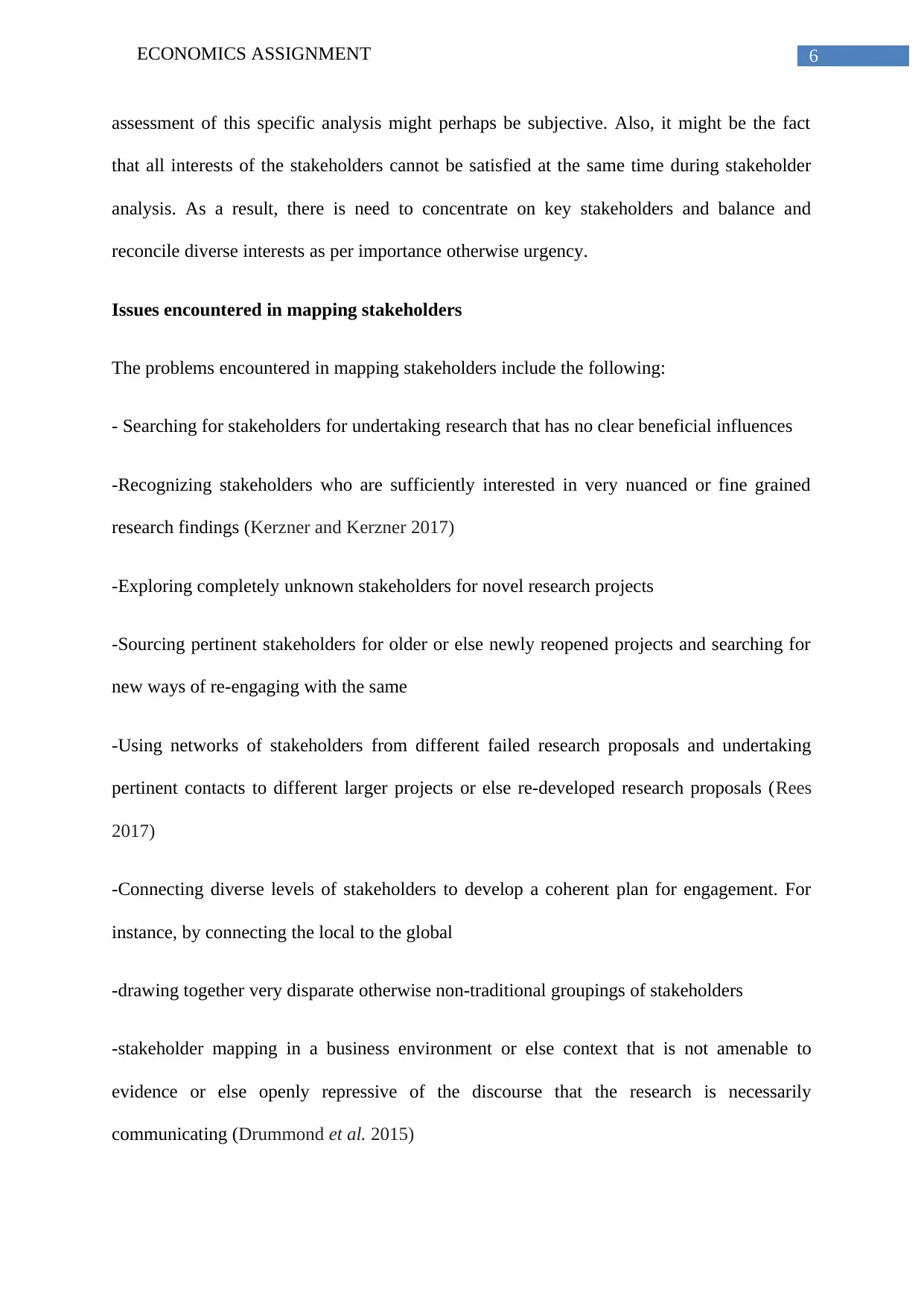
6ECONOMICS ASSIGNMENT
assessment of this specific analysis might perhaps be subjective. Also, it might be the fact
that all interests of the stakeholders cannot be satisfied at the same time during stakeholder
analysis. As a result, there is need to concentrate on key stakeholders and balance and
reconcile diverse interests as per importance otherwise urgency.
Issues encountered in mapping stakeholders
The problems encountered in mapping stakeholders include the following:
- Searching for stakeholders for undertaking research that has no clear beneficial influences
-Recognizing stakeholders who are sufficiently interested in very nuanced or fine grained
research findings (Kerzner and Kerzner 2017)
-Exploring completely unknown stakeholders for novel research projects
-Sourcing pertinent stakeholders for older or else newly reopened projects and searching for
new ways of re-engaging with the same
-Using networks of stakeholders from different failed research proposals and undertaking
pertinent contacts to different larger projects or else re-developed research proposals (Rees
2017)
-Connecting diverse levels of stakeholders to develop a coherent plan for engagement. For
instance, by connecting the local to the global
-drawing together very disparate otherwise non-traditional groupings of stakeholders
-stakeholder mapping in a business environment or else context that is not amenable to
evidence or else openly repressive of the discourse that the research is necessarily
communicating (Drummond et al. 2015)
assessment of this specific analysis might perhaps be subjective. Also, it might be the fact
that all interests of the stakeholders cannot be satisfied at the same time during stakeholder
analysis. As a result, there is need to concentrate on key stakeholders and balance and
reconcile diverse interests as per importance otherwise urgency.
Issues encountered in mapping stakeholders
The problems encountered in mapping stakeholders include the following:
- Searching for stakeholders for undertaking research that has no clear beneficial influences
-Recognizing stakeholders who are sufficiently interested in very nuanced or fine grained
research findings (Kerzner and Kerzner 2017)
-Exploring completely unknown stakeholders for novel research projects
-Sourcing pertinent stakeholders for older or else newly reopened projects and searching for
new ways of re-engaging with the same
-Using networks of stakeholders from different failed research proposals and undertaking
pertinent contacts to different larger projects or else re-developed research proposals (Rees
2017)
-Connecting diverse levels of stakeholders to develop a coherent plan for engagement. For
instance, by connecting the local to the global
-drawing together very disparate otherwise non-traditional groupings of stakeholders
-stakeholder mapping in a business environment or else context that is not amenable to
evidence or else openly repressive of the discourse that the research is necessarily
communicating (Drummond et al. 2015)
⊘ This is a preview!⊘
Do you want full access?
Subscribe today to unlock all pages.

Trusted by 1+ million students worldwide
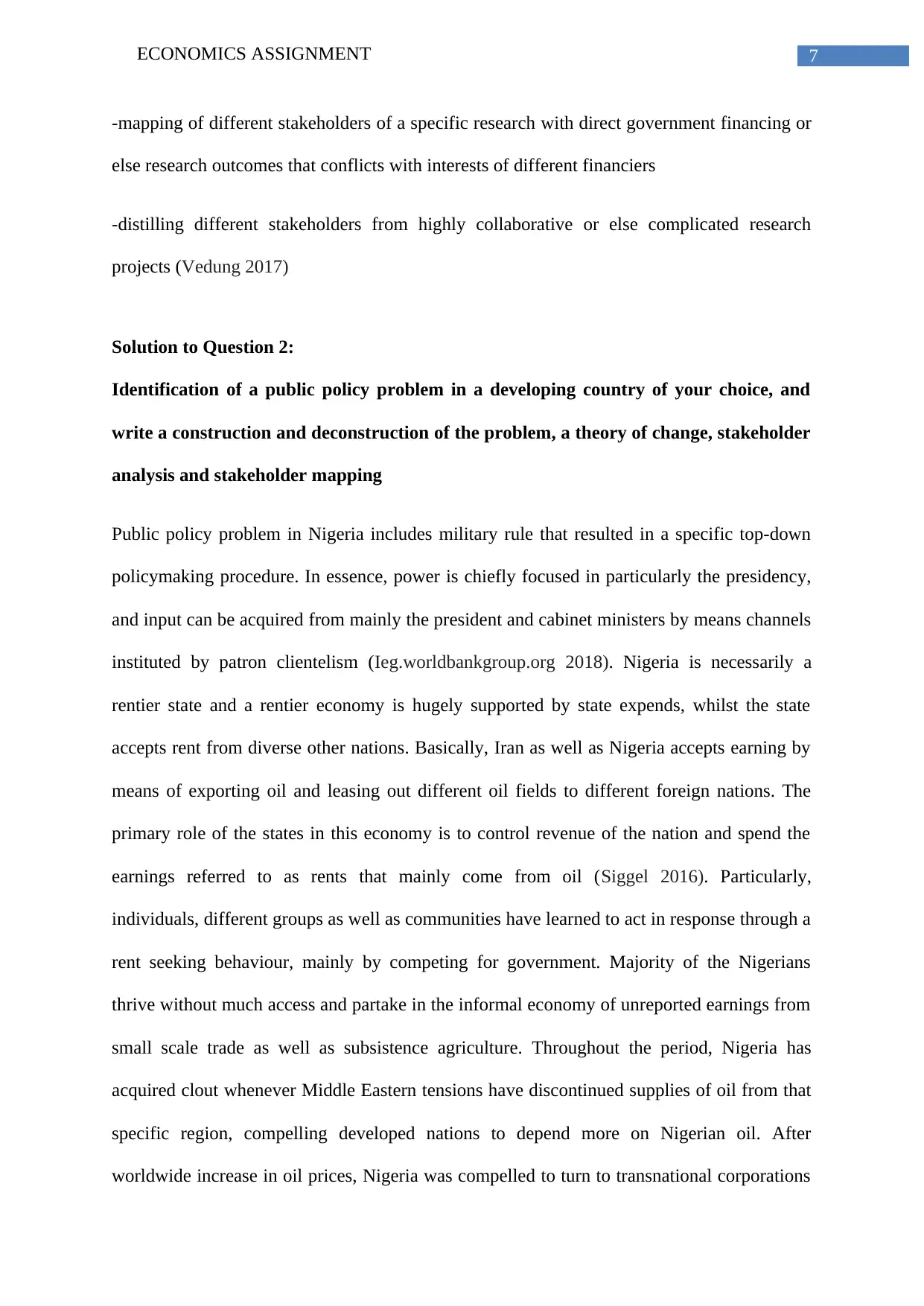
7ECONOMICS ASSIGNMENT
-mapping of different stakeholders of a specific research with direct government financing or
else research outcomes that conflicts with interests of different financiers
-distilling different stakeholders from highly collaborative or else complicated research
projects (Vedung 2017)
Solution to Question 2:
Identification of a public policy problem in a developing country of your choice, and
write a construction and deconstruction of the problem, a theory of change, stakeholder
analysis and stakeholder mapping
Public policy problem in Nigeria includes military rule that resulted in a specific top-down
policymaking procedure. In essence, power is chiefly focused in particularly the presidency,
and input can be acquired from mainly the president and cabinet ministers by means channels
instituted by patron clientelism (Ieg.worldbankgroup.org 2018). Nigeria is necessarily a
rentier state and a rentier economy is hugely supported by state expends, whilst the state
accepts rent from diverse other nations. Basically, Iran as well as Nigeria accepts earning by
means of exporting oil and leasing out different oil fields to different foreign nations. The
primary role of the states in this economy is to control revenue of the nation and spend the
earnings referred to as rents that mainly come from oil (Siggel 2016). Particularly,
individuals, different groups as well as communities have learned to act in response through a
rent seeking behaviour, mainly by competing for government. Majority of the Nigerians
thrive without much access and partake in the informal economy of unreported earnings from
small scale trade as well as subsistence agriculture. Throughout the period, Nigeria has
acquired clout whenever Middle Eastern tensions have discontinued supplies of oil from that
specific region, compelling developed nations to depend more on Nigerian oil. After
worldwide increase in oil prices, Nigeria was compelled to turn to transnational corporations
-mapping of different stakeholders of a specific research with direct government financing or
else research outcomes that conflicts with interests of different financiers
-distilling different stakeholders from highly collaborative or else complicated research
projects (Vedung 2017)
Solution to Question 2:
Identification of a public policy problem in a developing country of your choice, and
write a construction and deconstruction of the problem, a theory of change, stakeholder
analysis and stakeholder mapping
Public policy problem in Nigeria includes military rule that resulted in a specific top-down
policymaking procedure. In essence, power is chiefly focused in particularly the presidency,
and input can be acquired from mainly the president and cabinet ministers by means channels
instituted by patron clientelism (Ieg.worldbankgroup.org 2018). Nigeria is necessarily a
rentier state and a rentier economy is hugely supported by state expends, whilst the state
accepts rent from diverse other nations. Basically, Iran as well as Nigeria accepts earning by
means of exporting oil and leasing out different oil fields to different foreign nations. The
primary role of the states in this economy is to control revenue of the nation and spend the
earnings referred to as rents that mainly come from oil (Siggel 2016). Particularly,
individuals, different groups as well as communities have learned to act in response through a
rent seeking behaviour, mainly by competing for government. Majority of the Nigerians
thrive without much access and partake in the informal economy of unreported earnings from
small scale trade as well as subsistence agriculture. Throughout the period, Nigeria has
acquired clout whenever Middle Eastern tensions have discontinued supplies of oil from that
specific region, compelling developed nations to depend more on Nigerian oil. After
worldwide increase in oil prices, Nigeria was compelled to turn to transnational corporations
Paraphrase This Document
Need a fresh take? Get an instant paraphrase of this document with our AI Paraphraser
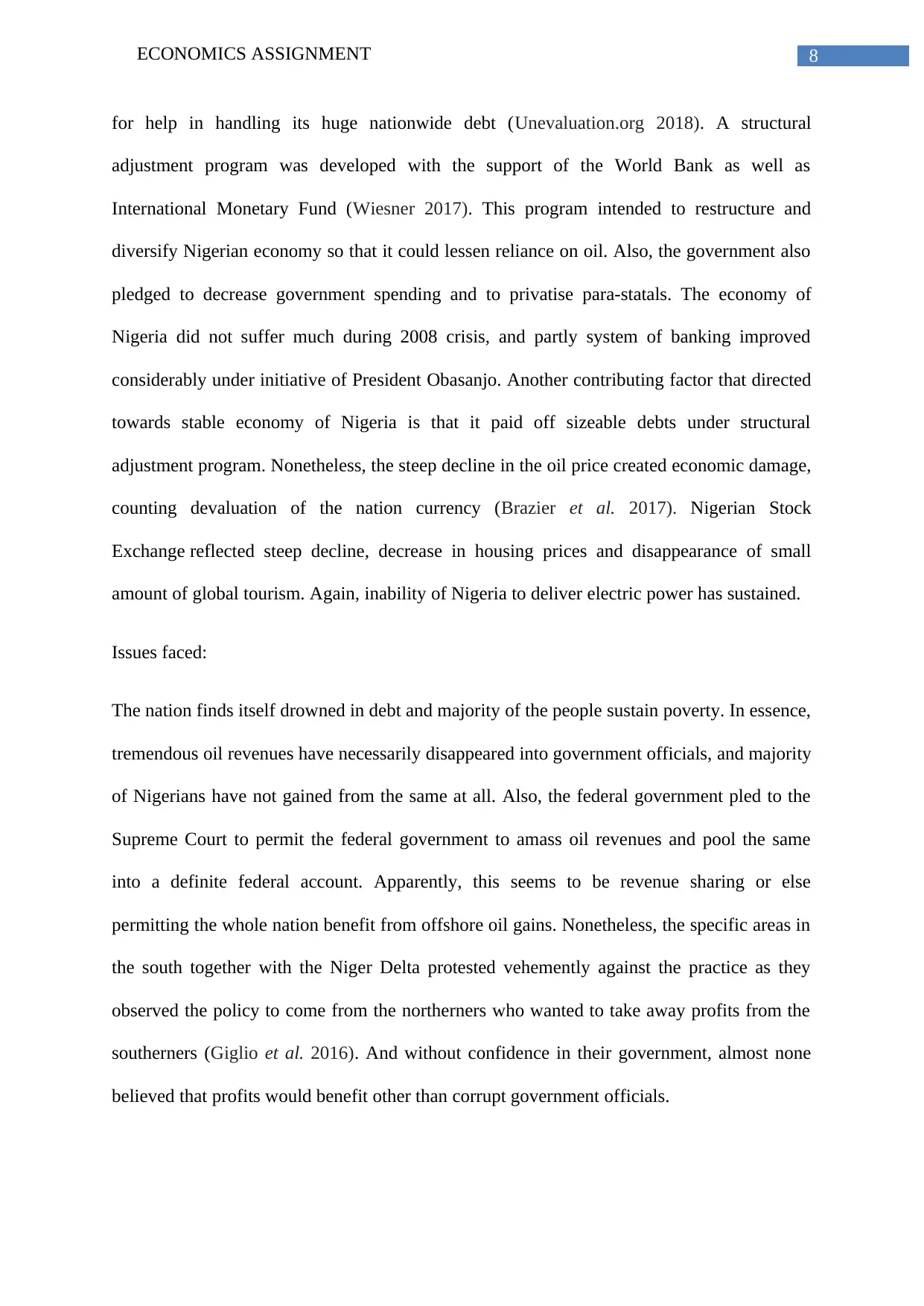
8ECONOMICS ASSIGNMENT
for help in handling its huge nationwide debt (Unevaluation.org 2018). A structural
adjustment program was developed with the support of the World Bank as well as
International Monetary Fund (Wiesner 2017). This program intended to restructure and
diversify Nigerian economy so that it could lessen reliance on oil. Also, the government also
pledged to decrease government spending and to privatise para-statals. The economy of
Nigeria did not suffer much during 2008 crisis, and partly system of banking improved
considerably under initiative of President Obasanjo. Another contributing factor that directed
towards stable economy of Nigeria is that it paid off sizeable debts under structural
adjustment program. Nonetheless, the steep decline in the oil price created economic damage,
counting devaluation of the nation currency (Brazier et al. 2017). Nigerian Stock
Exchange reflected steep decline, decrease in housing prices and disappearance of small
amount of global tourism. Again, inability of Nigeria to deliver electric power has sustained.
Issues faced:
The nation finds itself drowned in debt and majority of the people sustain poverty. In essence,
tremendous oil revenues have necessarily disappeared into government officials, and majority
of Nigerians have not gained from the same at all. Also, the federal government pled to the
Supreme Court to permit the federal government to amass oil revenues and pool the same
into a definite federal account. Apparently, this seems to be revenue sharing or else
permitting the whole nation benefit from offshore oil gains. Nonetheless, the specific areas in
the south together with the Niger Delta protested vehemently against the practice as they
observed the policy to come from the northerners who wanted to take away profits from the
southerners (Giglio et al. 2016). And without confidence in their government, almost none
believed that profits would benefit other than corrupt government officials.
for help in handling its huge nationwide debt (Unevaluation.org 2018). A structural
adjustment program was developed with the support of the World Bank as well as
International Monetary Fund (Wiesner 2017). This program intended to restructure and
diversify Nigerian economy so that it could lessen reliance on oil. Also, the government also
pledged to decrease government spending and to privatise para-statals. The economy of
Nigeria did not suffer much during 2008 crisis, and partly system of banking improved
considerably under initiative of President Obasanjo. Another contributing factor that directed
towards stable economy of Nigeria is that it paid off sizeable debts under structural
adjustment program. Nonetheless, the steep decline in the oil price created economic damage,
counting devaluation of the nation currency (Brazier et al. 2017). Nigerian Stock
Exchange reflected steep decline, decrease in housing prices and disappearance of small
amount of global tourism. Again, inability of Nigeria to deliver electric power has sustained.
Issues faced:
The nation finds itself drowned in debt and majority of the people sustain poverty. In essence,
tremendous oil revenues have necessarily disappeared into government officials, and majority
of Nigerians have not gained from the same at all. Also, the federal government pled to the
Supreme Court to permit the federal government to amass oil revenues and pool the same
into a definite federal account. Apparently, this seems to be revenue sharing or else
permitting the whole nation benefit from offshore oil gains. Nonetheless, the specific areas in
the south together with the Niger Delta protested vehemently against the practice as they
observed the policy to come from the northerners who wanted to take away profits from the
southerners (Giglio et al. 2016). And without confidence in their government, almost none
believed that profits would benefit other than corrupt government officials.
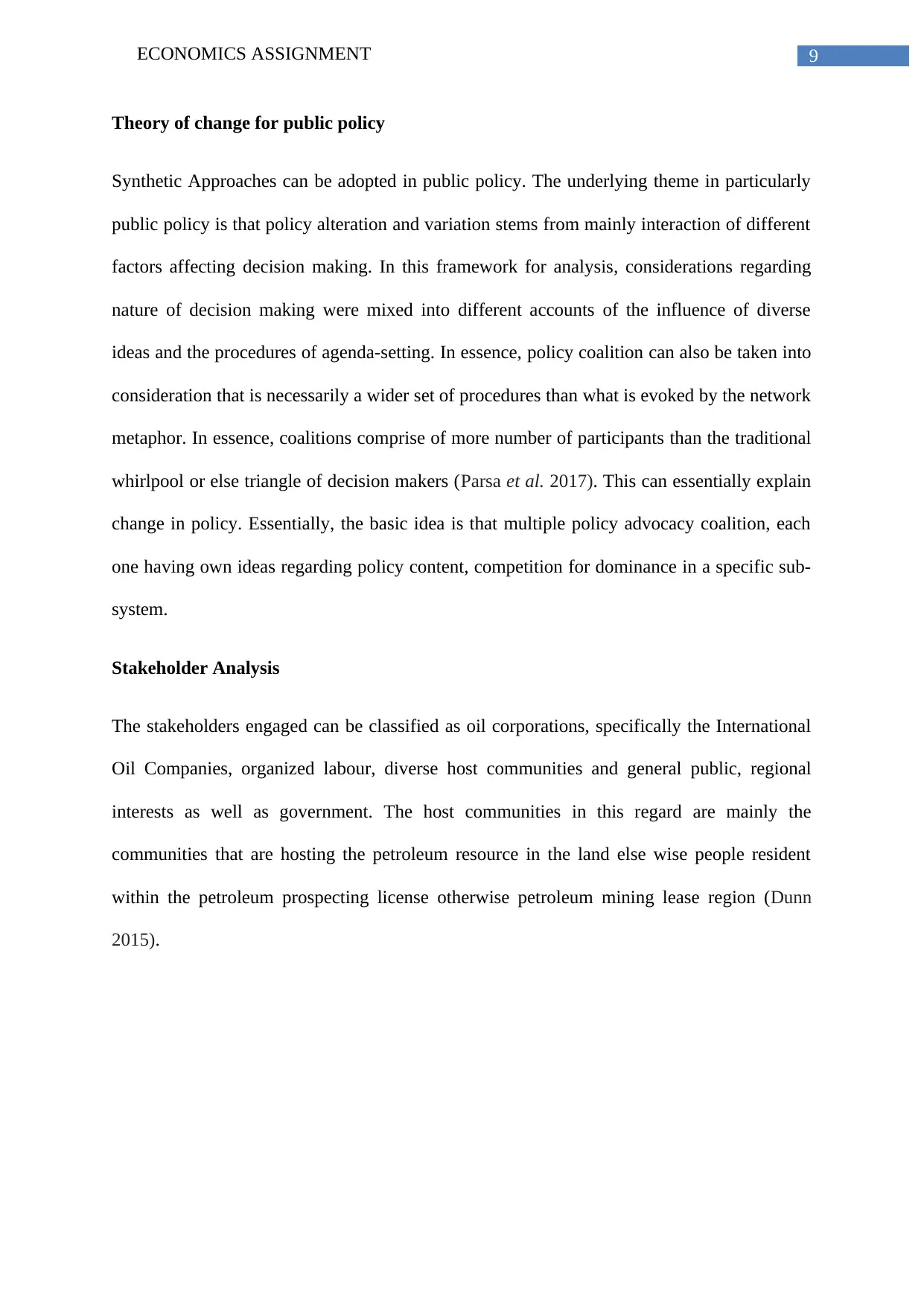
9ECONOMICS ASSIGNMENT
Theory of change for public policy
Synthetic Approaches can be adopted in public policy. The underlying theme in particularly
public policy is that policy alteration and variation stems from mainly interaction of different
factors affecting decision making. In this framework for analysis, considerations regarding
nature of decision making were mixed into different accounts of the influence of diverse
ideas and the procedures of agenda-setting. In essence, policy coalition can also be taken into
consideration that is necessarily a wider set of procedures than what is evoked by the network
metaphor. In essence, coalitions comprise of more number of participants than the traditional
whirlpool or else triangle of decision makers (Parsa et al. 2017). This can essentially explain
change in policy. Essentially, the basic idea is that multiple policy advocacy coalition, each
one having own ideas regarding policy content, competition for dominance in a specific sub-
system.
Stakeholder Analysis
The stakeholders engaged can be classified as oil corporations, specifically the International
Oil Companies, organized labour, diverse host communities and general public, regional
interests as well as government. The host communities in this regard are mainly the
communities that are hosting the petroleum resource in the land else wise people resident
within the petroleum prospecting license otherwise petroleum mining lease region (Dunn
2015).
Theory of change for public policy
Synthetic Approaches can be adopted in public policy. The underlying theme in particularly
public policy is that policy alteration and variation stems from mainly interaction of different
factors affecting decision making. In this framework for analysis, considerations regarding
nature of decision making were mixed into different accounts of the influence of diverse
ideas and the procedures of agenda-setting. In essence, policy coalition can also be taken into
consideration that is necessarily a wider set of procedures than what is evoked by the network
metaphor. In essence, coalitions comprise of more number of participants than the traditional
whirlpool or else triangle of decision makers (Parsa et al. 2017). This can essentially explain
change in policy. Essentially, the basic idea is that multiple policy advocacy coalition, each
one having own ideas regarding policy content, competition for dominance in a specific sub-
system.
Stakeholder Analysis
The stakeholders engaged can be classified as oil corporations, specifically the International
Oil Companies, organized labour, diverse host communities and general public, regional
interests as well as government. The host communities in this regard are mainly the
communities that are hosting the petroleum resource in the land else wise people resident
within the petroleum prospecting license otherwise petroleum mining lease region (Dunn
2015).
⊘ This is a preview!⊘
Do you want full access?
Subscribe today to unlock all pages.

Trusted by 1+ million students worldwide
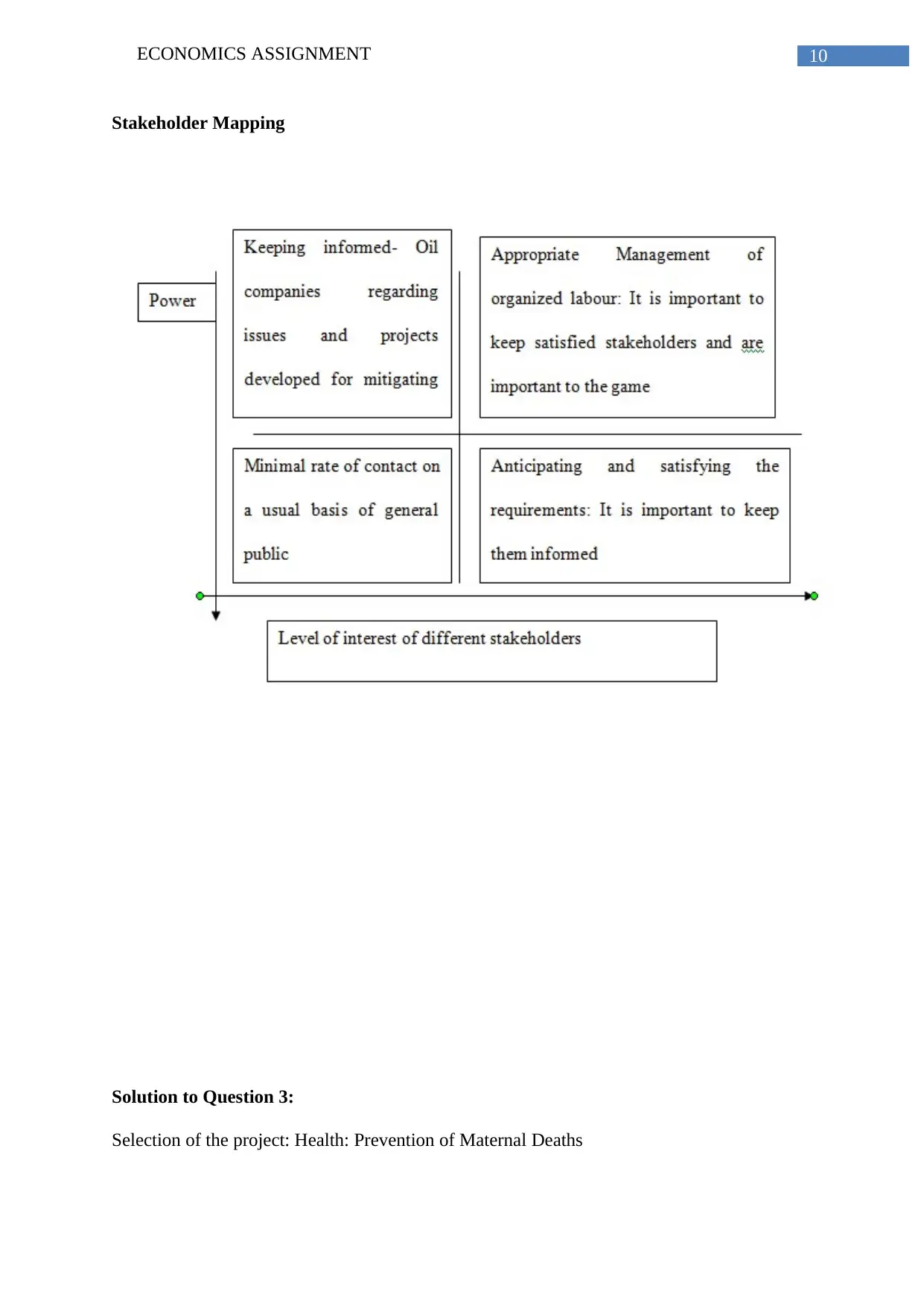
10ECONOMICS ASSIGNMENT
Stakeholder Mapping
Solution to Question 3:
Selection of the project: Health: Prevention of Maternal Deaths
Stakeholder Mapping
Solution to Question 3:
Selection of the project: Health: Prevention of Maternal Deaths
Paraphrase This Document
Need a fresh take? Get an instant paraphrase of this document with our AI Paraphraser
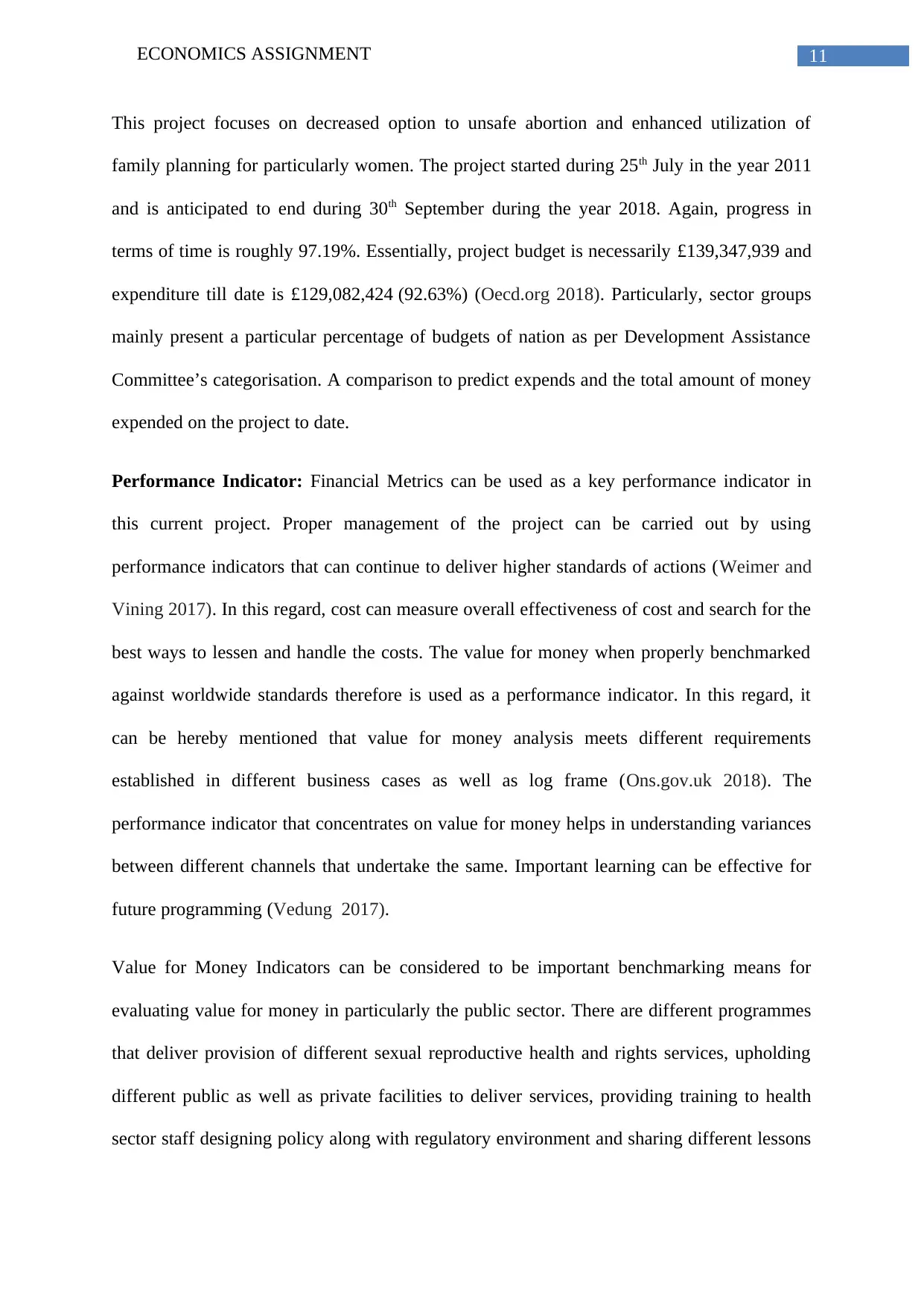
11ECONOMICS ASSIGNMENT
This project focuses on decreased option to unsafe abortion and enhanced utilization of
family planning for particularly women. The project started during 25th July in the year 2011
and is anticipated to end during 30th September during the year 2018. Again, progress in
terms of time is roughly 97.19%. Essentially, project budget is necessarily £139,347,939 and
expenditure till date is £129,082,424 (92.63%) (Oecd.org 2018). Particularly, sector groups
mainly present a particular percentage of budgets of nation as per Development Assistance
Committee’s categorisation. A comparison to predict expends and the total amount of money
expended on the project to date.
Performance Indicator: Financial Metrics can be used as a key performance indicator in
this current project. Proper management of the project can be carried out by using
performance indicators that can continue to deliver higher standards of actions (Weimer and
Vining 2017). In this regard, cost can measure overall effectiveness of cost and search for the
best ways to lessen and handle the costs. The value for money when properly benchmarked
against worldwide standards therefore is used as a performance indicator. In this regard, it
can be hereby mentioned that value for money analysis meets different requirements
established in different business cases as well as log frame (Ons.gov.uk 2018). The
performance indicator that concentrates on value for money helps in understanding variances
between different channels that undertake the same. Important learning can be effective for
future programming (Vedung 2017).
Value for Money Indicators can be considered to be important benchmarking means for
evaluating value for money in particularly the public sector. There are different programmes
that deliver provision of different sexual reproductive health and rights services, upholding
different public as well as private facilities to deliver services, providing training to health
sector staff designing policy along with regulatory environment and sharing different lessons
This project focuses on decreased option to unsafe abortion and enhanced utilization of
family planning for particularly women. The project started during 25th July in the year 2011
and is anticipated to end during 30th September during the year 2018. Again, progress in
terms of time is roughly 97.19%. Essentially, project budget is necessarily £139,347,939 and
expenditure till date is £129,082,424 (92.63%) (Oecd.org 2018). Particularly, sector groups
mainly present a particular percentage of budgets of nation as per Development Assistance
Committee’s categorisation. A comparison to predict expends and the total amount of money
expended on the project to date.
Performance Indicator: Financial Metrics can be used as a key performance indicator in
this current project. Proper management of the project can be carried out by using
performance indicators that can continue to deliver higher standards of actions (Weimer and
Vining 2017). In this regard, cost can measure overall effectiveness of cost and search for the
best ways to lessen and handle the costs. The value for money when properly benchmarked
against worldwide standards therefore is used as a performance indicator. In this regard, it
can be hereby mentioned that value for money analysis meets different requirements
established in different business cases as well as log frame (Ons.gov.uk 2018). The
performance indicator that concentrates on value for money helps in understanding variances
between different channels that undertake the same. Important learning can be effective for
future programming (Vedung 2017).
Value for Money Indicators can be considered to be important benchmarking means for
evaluating value for money in particularly the public sector. There are different programmes
that deliver provision of different sexual reproductive health and rights services, upholding
different public as well as private facilities to deliver services, providing training to health
sector staff designing policy along with regulatory environment and sharing different lessons
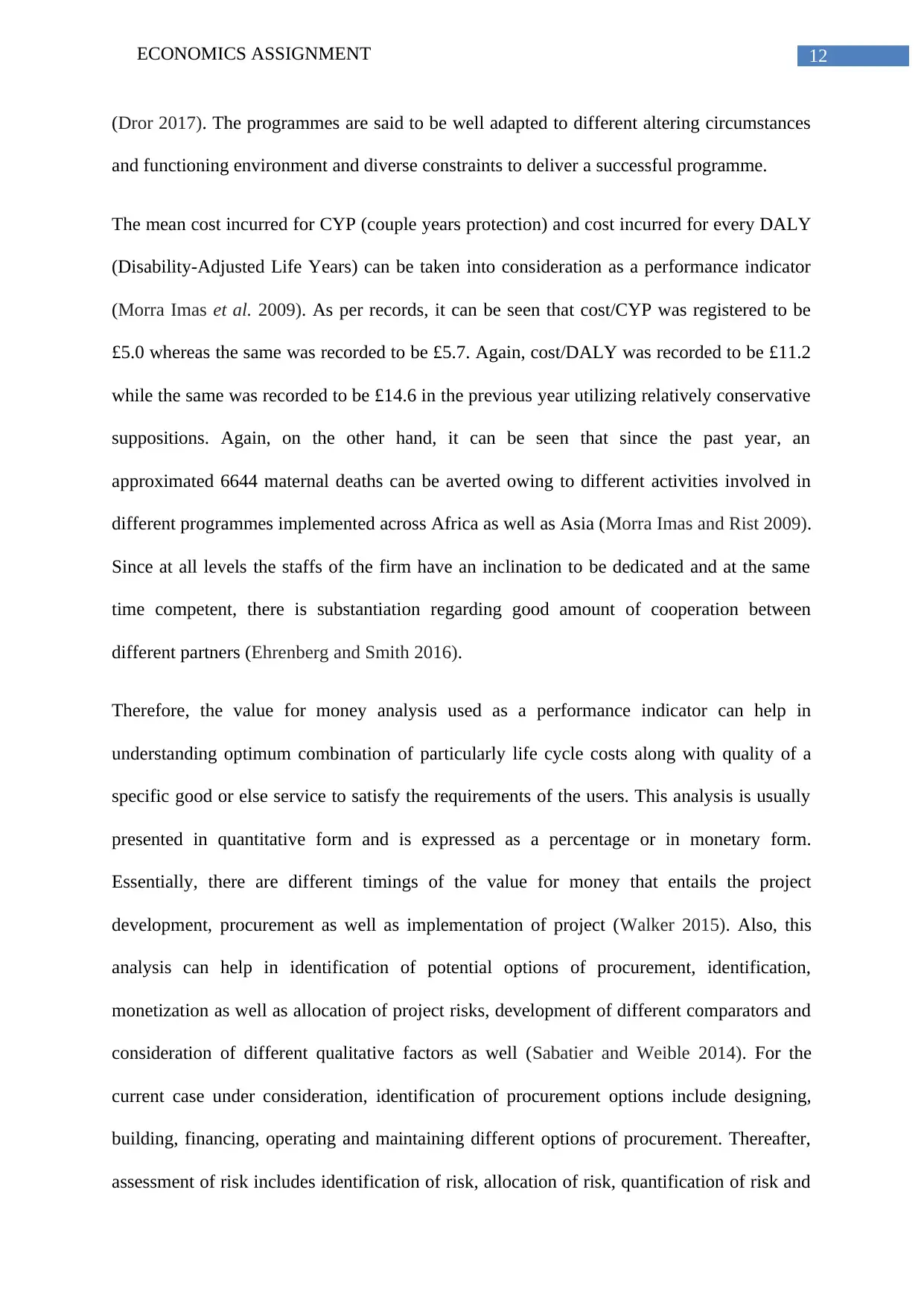
12ECONOMICS ASSIGNMENT
(Dror 2017). The programmes are said to be well adapted to different altering circumstances
and functioning environment and diverse constraints to deliver a successful programme.
The mean cost incurred for CYP (couple years protection) and cost incurred for every DALY
(Disability-Adjusted Life Years) can be taken into consideration as a performance indicator
(Morra Imas et al. 2009). As per records, it can be seen that cost/CYP was registered to be
£5.0 whereas the same was recorded to be £5.7. Again, cost/DALY was recorded to be £11.2
while the same was recorded to be £14.6 in the previous year utilizing relatively conservative
suppositions. Again, on the other hand, it can be seen that since the past year, an
approximated 6644 maternal deaths can be averted owing to different activities involved in
different programmes implemented across Africa as well as Asia (Morra Imas and Rist 2009).
Since at all levels the staffs of the firm have an inclination to be dedicated and at the same
time competent, there is substantiation regarding good amount of cooperation between
different partners (Ehrenberg and Smith 2016).
Therefore, the value for money analysis used as a performance indicator can help in
understanding optimum combination of particularly life cycle costs along with quality of a
specific good or else service to satisfy the requirements of the users. This analysis is usually
presented in quantitative form and is expressed as a percentage or in monetary form.
Essentially, there are different timings of the value for money that entails the project
development, procurement as well as implementation of project (Walker 2015). Also, this
analysis can help in identification of potential options of procurement, identification,
monetization as well as allocation of project risks, development of different comparators and
consideration of different qualitative factors as well (Sabatier and Weible 2014). For the
current case under consideration, identification of procurement options include designing,
building, financing, operating and maintaining different options of procurement. Thereafter,
assessment of risk includes identification of risk, allocation of risk, quantification of risk and
(Dror 2017). The programmes are said to be well adapted to different altering circumstances
and functioning environment and diverse constraints to deliver a successful programme.
The mean cost incurred for CYP (couple years protection) and cost incurred for every DALY
(Disability-Adjusted Life Years) can be taken into consideration as a performance indicator
(Morra Imas et al. 2009). As per records, it can be seen that cost/CYP was registered to be
£5.0 whereas the same was recorded to be £5.7. Again, cost/DALY was recorded to be £11.2
while the same was recorded to be £14.6 in the previous year utilizing relatively conservative
suppositions. Again, on the other hand, it can be seen that since the past year, an
approximated 6644 maternal deaths can be averted owing to different activities involved in
different programmes implemented across Africa as well as Asia (Morra Imas and Rist 2009).
Since at all levels the staffs of the firm have an inclination to be dedicated and at the same
time competent, there is substantiation regarding good amount of cooperation between
different partners (Ehrenberg and Smith 2016).
Therefore, the value for money analysis used as a performance indicator can help in
understanding optimum combination of particularly life cycle costs along with quality of a
specific good or else service to satisfy the requirements of the users. This analysis is usually
presented in quantitative form and is expressed as a percentage or in monetary form.
Essentially, there are different timings of the value for money that entails the project
development, procurement as well as implementation of project (Walker 2015). Also, this
analysis can help in identification of potential options of procurement, identification,
monetization as well as allocation of project risks, development of different comparators and
consideration of different qualitative factors as well (Sabatier and Weible 2014). For the
current case under consideration, identification of procurement options include designing,
building, financing, operating and maintaining different options of procurement. Thereafter,
assessment of risk includes identification of risk, allocation of risk, quantification of risk and
⊘ This is a preview!⊘
Do you want full access?
Subscribe today to unlock all pages.

Trusted by 1+ million students worldwide
1 out of 21
Related Documents
Your All-in-One AI-Powered Toolkit for Academic Success.
+13062052269
info@desklib.com
Available 24*7 on WhatsApp / Email
![[object Object]](/_next/static/media/star-bottom.7253800d.svg)
Unlock your academic potential
Copyright © 2020–2025 A2Z Services. All Rights Reserved. Developed and managed by ZUCOL.





